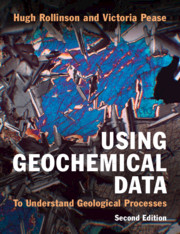Book contents
- Using Geochemical Data
- Reviews
- Using Geochemical Data
- Copyright page
- Contents
- Preface to the Second Edition
- Preface to the First Edition
- Abbreviations
- 1 Geochemical Data
- 2 Analysing Geochemical Data
- 3 Using Major Element Data
- 4 Using Trace Element Data
- 5 Using Geochemical Data to Identify Tectonic Environments
- 6 Using Radiogenic Isotope Data
- 7 Using Stable Isotope Data
- Appendices
- References
- Index
2 - Analysing Geochemical Data
Published online by Cambridge University Press: 15 April 2021
- Using Geochemical Data
- Reviews
- Using Geochemical Data
- Copyright page
- Contents
- Preface to the Second Edition
- Preface to the First Edition
- Abbreviations
- 1 Geochemical Data
- 2 Analysing Geochemical Data
- 3 Using Major Element Data
- 4 Using Trace Element Data
- 5 Using Geochemical Data to Identify Tectonic Environments
- 6 Using Radiogenic Isotope Data
- 7 Using Stable Isotope Data
- Appendices
- References
- Index
Summary
The statistical analysis of geochemical data employs the main statistical techniques of averaging, probability distributions, correlation, regression, multivariate analysis and discriminant analysis. A particular problem with major element geochemical data is that it is constrained; that is, the compositions sum to 100% and the data are ‘closed’. A related problem arises when ternary plots are used to display geochemical data. Techniques are described to accommodate the problems associated with compositional data which include log-ratio conversions and the biplot diagram. Further statistical problems arise in the area of ratio correlation as advocated in Pearce element ratio diagrams, which is not recommended. Applications to trace elements and radiogenic isotope correlations are discussed. The details of discriminant analysis are outlined as a prelude to a more detailed discussion of tectonic discrimination diagrams considered in Chapter 5.
Keywords
Information
- Type
- Chapter
- Information
- Using Geochemical DataTo Understand Geological Processes, pp. 20 - 48Publisher: Cambridge University PressPrint publication year: 2021
Accessibility standard: Unknown
Why this information is here
This section outlines the accessibility features of this content - including support for screen readers, full keyboard navigation and high-contrast display options. This may not be relevant for you.Accessibility Information
- 2
- Cited by
